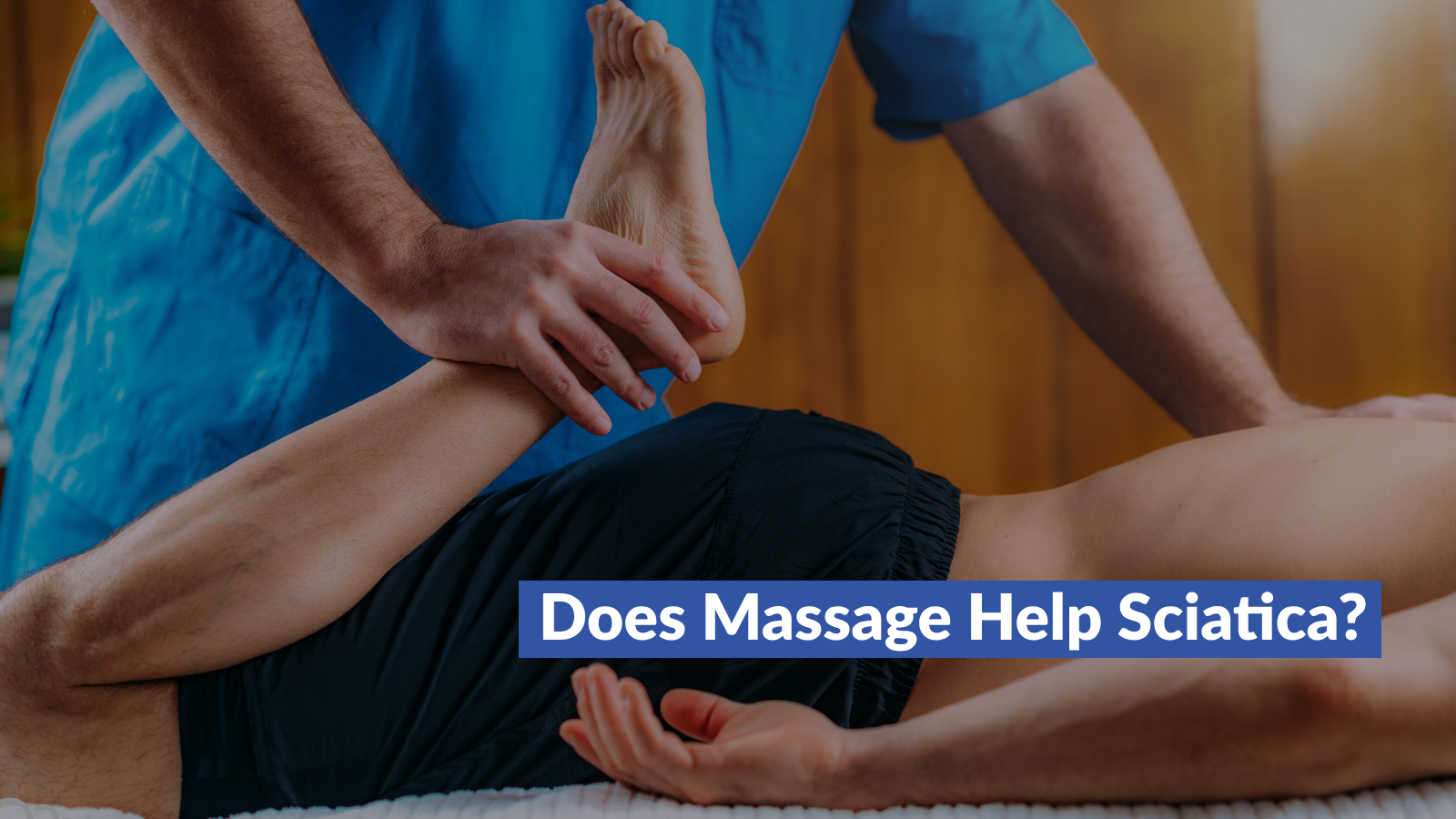That tingling sensation in your leg isn’t just annoying; it could be a sign of sciatica! Did you know? About 40% of people experience sciatica at some point in their lifetime. Most people opt for traditional ways which include massage as well. The question is:does massage help sciatica? The answer to which is: Yes, definitely. Massage is one of the most effective ways to manage sciatica pain. Let’s learn how deep tissue massage can be a key part to manage sciatica pain.
What Causes Sciatica?
Sciatica is caused by irritation or compression of the sciatic nerve, which runs from the lower back down through the legs. Here are the main reasons that can lead to sciatica:
Herniated Disc: A herniated or slipped disc occurs when the inner gel-like material of a spinal disc protrudes and presses on the sciatic nerve.
Spinal Stenosis: This condition involves narrowing of the spinal canal, which can compress the sciatic nerve roots.
Degenerative Disc Disease: As spinal discs lose their cushioning ability over time, they can lead to nerve compression and sciatica.
Spondylolisthesis: This occurs when a vertebra slips out of place, potentially pinching the sciatic nerve.
Piriformis Syndrome: The piriformis muscle, located in the buttocks, can irritate the sciatic nerve if it becomes tight or inflamed.
Lumbar Spinal Injury: Trauma or injury to the lower spine, such as fractures, can cause sciatica.
Spinal Tumors: Rarely, tumors in the spinal column can press on the sciatic nerve or its roots.
Pregnancy: The growing uterus can place pressure on the sciatic nerve, especially in the later stages of pregnancy.
Poor Posture: Chronic poor posture or prolonged sitting can contribute to sciatic nerve compression.
Obesity: Excess weight can put added stress on the spine and contribute to conditions that cause sciatica.
Muscle Imbalances: Imbalances in the muscles of the lower back, hips, or pelvis can lead to sciatic nerve irritation.
Infections: Infections of the spine, such as discitis or osteomyelitis, can cause inflammation and nerve compression.
Arthritis: Osteoarthritis or rheumatoid arthritis can lead to bone spurs or inflammation in the spine that impacts the sciatic nerve.
Sedentary Lifestyle: Lack of regular exercise can weaken back muscles and contribute to conditions that cause sciatica.
Benefits of Massage for Sciatica
Experiencing sciatica pain and wondering does massage help sciatica? The answer is a resounding yes! Here’s how:
Loosen and Relax Muscles
Massage therapy helps to loosen and relax tight muscles around the sciatic nerve. By easing muscle tension, it alleviates pressure on the nerve, answering the question “does massage help sciatica”—it certainly does!
Release Endorphins
One of the great benefits of massage is its ability to release endorphins, the body’s natural painkillers. These feel-good hormones can help manage sciatica pain, showing how does massage help sciatica by enhancing overall well-being.
Boost Flexibility and Range of Motion
Regular massage improves flexibility and range of motion by working on stiff and tight muscles. This increased mobility aids in managing sciatica, reinforcing that massage helps sciatica.
Reduce Stress and Anxiety
Massage therapy not only targets physical pain but also helps to reduce stress and anxiety. Since stress can exacerbate sciatica, lowering it leads to more effective pain management, illustrating how does massage help sciatica by providing comprehensive relief.
Types of Massage for Sciatica
Corrective Movement Therapy
Improper posture and movement patterns can exacerbate sciatica. Corrective movement therapy targets these issues by focusing on proper alignment, helping to relieve sciatic nerve pressure and prevent future flare-ups. Corrective movement therapy works by addressing posture and muscle imbalances that contribute to sciatica.
By improving alignment and correcting dysfunctional movement patterns, it reduces strain on the lower back and pelvis, alleviating pressure on the sciatic nerve and preventing recurring pain.
Pain and Injury Massage
Nearly 80% of people experience back pain in their lives, often linked to sciatica. Pain and injury massage targets the underlying muscle tension and inflammation, providing much-needed relief and promoting healing. Pain and injury massage focuses on relieving muscle tension and reducing inflammation around the sciatic nerve.
This massage technique improves blood flow, relaxes tight muscles, and decreases inflammation, which can significantly ease sciatic pain and aid in long-term recovery.
Deep Tissue Massage
Chronic muscle tension can aggravate sciatica, making everyday activities painful. Deep tissue massage offers a solution by reaching deeper muscle layers, breaking down adhesions, and enhancing circulation, which eases pain. Deep tissue massage applies firm pressure to reach deeper layers of muscle and connective tissue.
This technique helps by breaking down scar tissue and adhesions, releasing chronic muscle tension, and improving circulation, which can reduce sciatic nerve pain and promote muscle health.
Osteopathy Massage Therapy
Osteopathy massage therapy offers a holistic approach to treating sciatica by addressing the entire musculoskeletal system. This gentle manipulation helps realign the body, reducing nerve compression and promoting overall wellness.
Osteopathy massage therapy focuses on the holistic balance of the musculoskeletal system. By gently manipulating muscles, joints, and ligaments, it helps realign the spine and pelvis, reducing nerve compression and relieving sciatica pain while promoting overall body balance and health.
Trigger Point Therapy
Trigger points in the muscles can contribute to sciatica pain by causing referred pain in the lower back and legs. Trigger point therapy specifically targets these points to relieve discomfort and restore muscle function.
Trigger point therapy involves applying pressure to specific areas of muscle tension, known as trigger points. By releasing these points, it alleviates referred pain that affects the sciatic nerve, reduces muscle tightness, and improves overall mobility and comfort.
Neuromuscular Massage
Research indicates that neuromuscular massage can significantly reduce sciatica symptoms by targeting specific muscle groups and nerve pathways. This approach enhances pain relief and improves function.
Neuromuscular massage addresses the relationship between muscles and nerves, focusing on areas of muscle dysfunction and nerve irritation. By improving blood flow, releasing tight muscles, and addressing nerve compression, it helps to alleviate sciatic pain and improve movement and function.
So, does massage help sciatica? Absolutely! By incorporating massage into your routine, you can experience these benefits and find relief from sciatica pain.
Osteopath Sydney Can Help Your Sciatica!
Battling with sciatica pain? Osteopathy in Sydney offers effective relief tailored just for you.
Osteopathy for sciatica utilizes specialized techniques to address the root causes of pain. By focusing on spinal alignment and muscle balance, osteopathy techniques for sciatica can relieve pressure on the sciatic nerve and improve mobility.
Sciatica care with osteopathy includes gentle manipulation and targeted treatments that reduce discomfort and prevent future issues.
If sciatica pain is affecting your life in Australia, contact an Osteopath Sydney today. Discover how osteopathy for sciatica relief can make a difference and help you feel better.


